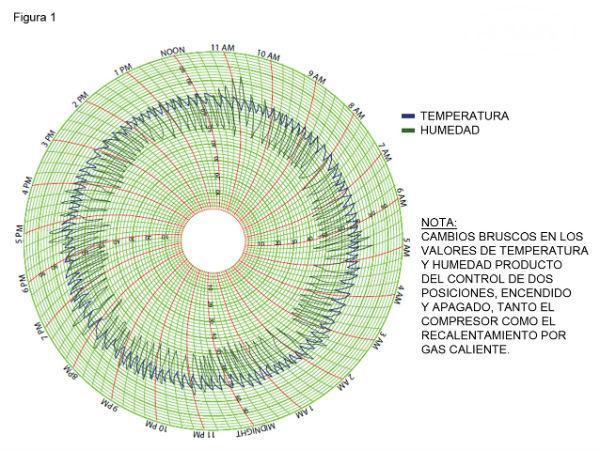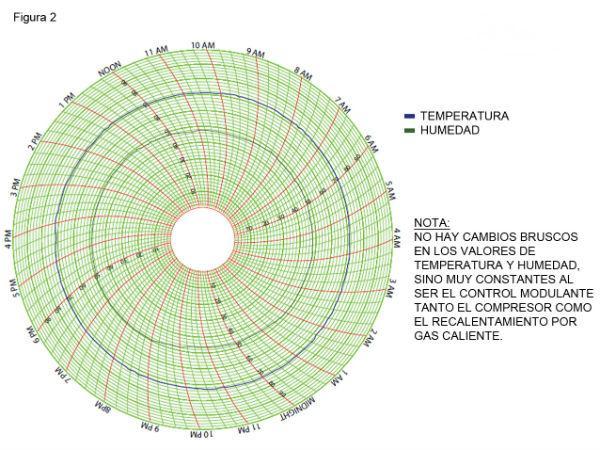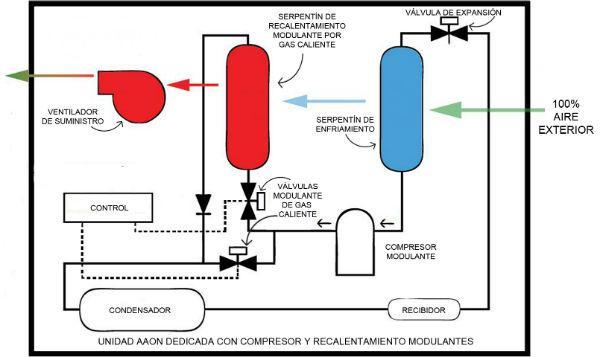 We analyze the operation of the air conditioning units in terms of temperature and humidity control to avoid high fluctuations.
We analyze the operation of the air conditioning units in terms of temperature and humidity control to avoid high fluctuations.
by Alfredo Sotolongo*
The most economical energy to produce is the one that is saved!
The situation with the enthalpy in our tropical countries, which reflects the high humidity and temperature of the outside air is what most attracts the attention of those who read my writings. The control of air temperature and humidity, among other things, are very important for the quality of the air inside the conditioned areas.
The use of two-position controls, on and off, has prevailed for many years. Exaggerated fluctuations in temperature and humidity occur with this type of control, please refer to Figure 1.

Figure 1.
The control of two positions has evolved and now there are much superior modulating control systems that proportionally regulate temperature and humidity avoiding exaggerated fluctuations, please refer to Figure 2.

Figure 2.
In the case of two-position control, when the compressor starts, it cools the air to its maximum capacity by reducing the air temperature below the thermostat control point (Dead Band). When the temperature in the conditioned area drops to the lower limit of the thermostat (Dead Band), the compressor shuts down. Then the sensitive heat of the conditioned area causes the air temperature to rise past the checkpoint and reach the upper limit of the thermostat (Dead Band). Upon reaching this value, the compressor starts again and the cycle is repeated.
When the air in the air conditioning unit cools, the water vapor in the air condenses and rushes into the condensation tray. For example, when a cold liquid is poured into a glass, the outside of the glass sweats and this is because the water vapor found in the air around the glass condenses and precipitates. When the air cools it loses its property of holding water vapor. In a conditioned area the water vapor in the air condenses when cooled through the coil in the same way that it happens on the outside of the glass.
When the air is lowered to remove as much water vapor as possible, it is in a condition of saturation, 100% relative humidity. And so it comes out of the coil of the air conditioning unit. In the case of low percentage of outside air (15%-25%), it is not always necessary to reheat it since the sensitive heat of the conditioned area is removed by the total air handled by the unit and ends up in conditions of neutral air 75⁰F dry bulb and 50% relative humidity. In cases where we have to overcool the air to dry it as much as possible and the sensitive load of the conditioned area is not enough, then we have to reheat it by adding sensitive heat. The sensitive heat that is added should be without expending additional energy.
In the case of 100% outside air, which is the most critical case, the air that comes out saturated from the coil must be reheated by applying sensitive heat until it is brought as close as possible to neutral air conditions. Normally a unit dedicated to processing 100% outdoor air (DOAS) supplies neutral air (75⁰F and 50% RH) to the rest of the air conditioning units and the capacity of these units is not affected. This is achieved using modulating compressors along with hot gas modulating reheating as shown in the diagram of the dedicated AAON DOAS unit.

Figure 3.
The best way to achieve this, as recommended by the manufacturer AAON, is to use dedicated units (DOAS) of direct expansion, even when the rest of the units use cold water in their coils. It is the most accurate and reliable control system.
If you need more information on any of the topics covered in this column, please contact me at the mail: [email protected]
* President of Protec, Inc., is certified as a professional engineer in Puerto Rico and the state of Florida; has more than 40 years of experience in the application and sale of systems and equipment for energy conservation. He is a member of ASME (American Society of Mechanical Engineers), AEE (Association of Energy Engineers), ASHRAE and was president of the Miami chapter of that association.















Toda la información es muy importante, muchas gracias
Gracias Wilson por seguir nuestros contenidos.
Saludos de parte del equipo de ACR Latinoamérica.